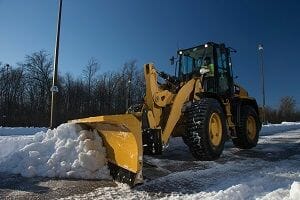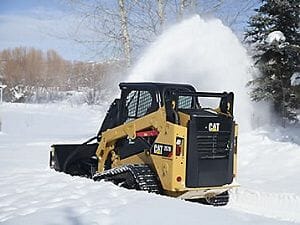- EQUIPMENT
- ATTACHMENTS
- POWER SYSTEMS
- TECHNOLOGY
- AGRICULTURE
October 31, 2017

 To prepare for frosty winter conditions, you must take steps to safeguard your outdoor equipment. With the following 11 steps, you can ensure your machines and equipment remain healthy and robust through all months of the year.
To prepare for frosty winter conditions, you must take steps to safeguard your outdoor equipment. With the following 11 steps, you can ensure your machines and equipment remain healthy and robust through all months of the year.
In advance of the impending winter cold, fill the fluid compartments with lubricants of the proper viscosity. Before you power on a machine, check the transmission and hydraulic components, as well as the oil tank, to ensure the fluid levels are optimal for the flow of the machine. Pull the dipstick out from each fluid container before each operation — if the fluid drips from the stick, the compartment is sufficiently lubricated. Do not use oil that has been thinned with kerosene.
Other components to double-check before each use throughout the winter are hydraulic hoses, which can crack if strained under cold conditions. To condition the hoses for wintertime operations in advance of each use, run the motor to raise the hydraulic oil to 150 degrees Fahrenheit, and continue to run the machine for a minimum of 60 minutes. For optimal performance, use a specially formulated arctic hydraulic oil during winter months.
 When freezing winds and snowfall hit, the effects can be damaging to the exterior and internal components of outdoor machines and equipment. After a snowstorm, you’d need to brush the snow and ice from the body of an exposed snow plow just to run it across your driveway. In worst-case scenarios, you might have to dig the plow out from several inches of snow. Meanwhile, the engine fluids within a machine could freeze if left exposed to subzero temperatures.
When freezing winds and snowfall hit, the effects can be damaging to the exterior and internal components of outdoor machines and equipment. After a snowstorm, you’d need to brush the snow and ice from the body of an exposed snow plow just to run it across your driveway. In worst-case scenarios, you might have to dig the plow out from several inches of snow. Meanwhile, the engine fluids within a machine could freeze if left exposed to subzero temperatures.
Throughout the weeks and months when your machines are not in use, store everything inside an enclosed facility. This way, the machines will be protected from the wintertime elements. For best results, remove any attachment parts and store them separately. Furthermore, keep all fluids specially stored in a room-temperature setting to protect the viscosity.
For most outdoor machines, the quickest way to warm the engine is with the use of a block heater, which can raise the temperatures of interior components and hydraulic fluid. To make this process as fast as possible, block the flow of the engine fan from the radiator as you warm the machine.
When temperatures drop below normal, a battery needs double the number of cranking amps to power on a machine. In order to make the startup process easier on the battery, keep it charged and sufficiently warm throughout the winter months. If the temperatures in your area drop to subzero levels, remove the battery from the machine and store it in a room-temperature setting during weeks when the machine is not in use.
Have starting fluid handy for the wintertime startup of outdoor machines. Make sure that starting fluid is stored properly in a room-temperature setting between uses. Beware — the toxic, flammable nature of starting fluid can render the product dangerous if not properly isolated, so never store the fluid alongside combustible materials. Inject the fluid as the engine cranks for optimal startup performance. It is important to know that starting fluid should only be used on certain machines. Contact your nearest Altorfer location before using starting fluid on your machine.
Before you put a machine to use, run it in idle until the engine reaches full operating temperature. This way, you’ll prevent sticking in the valves of the intake and exhaust systems. As you run the machine along your yard or driveway, activate each of the functions for a minute to distribute oil throughout the machine body. This step will give the machine a workout, so to speak, and help keep the engine and its functions in proper working condition.
 When temperatures drop, tires can lose air more rapidly. To ensure tires are sufficiently filled to support the weight of a machine, inspect each tire every time before you put the machine to use. For optimal seating of the tire bead, inflate each tire in an area with access to a heat supply, such as in your garage.
When temperatures drop, tires can lose air more rapidly. To ensure tires are sufficiently filled to support the weight of a machine, inspect each tire every time before you put the machine to use. For optimal seating of the tire bead, inflate each tire in an area with access to a heat supply, such as in your garage.
One of the worst problems that can develop inside of a tire is the formation of ice crystals, which can occur under subzero temperatures and exacerbate deflation issues. To prevent this from happening, inflate each tire with dry nitrogen gas.
In advance of each use, perform a visual inspection of the outer body, engine components and underside of your outdoor equipment. Make sure the parts inside the engine — including all the wires and hoses — are in clean, optimal working condition and free of wear or cracks. If you notice any abrasions along the hydraulic hoses, tires or belts, replace those parts immediately.
If snow or dirt are present along the tires or underside components, clean the spots in question before starting up the machine. To ensure the undercarriage of an outdoor machine is in healthy shape for the winter, have the machine inspected by a licensed specialist in advance of the cold season.
When temperatures drop to 12 degrees or lower, diesel fluid within an exposed container will freeze into sludgy crystal-laden form. To prevent this from happening, store diesel exhaust fluid containers in a room-temperature setting with sufficient insulation.
If you do store diesel exhaust fuel, make sure the container itself is non-expansive. This way, if the fluid thaws, it won’t burst through the container. It is also important to note that DEF fluid has a limited shelf life in comparison to other fluids. Always be aware of the expiration date of the material.
To prevent the fuel tank from freezing overnight in the midst of a cold stretch, refill the tank after each use. Also, clean and drain the water separator after each use, in advance of the refill. This step will help protect the fuel tank from the leak-over of dirt, sediment and water. With a clean fuel system, the machine will be better-equipped to handle even the coldest of winter seasons.